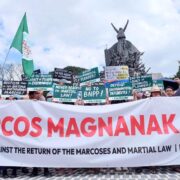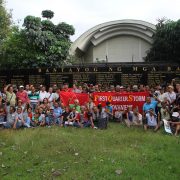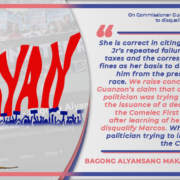An EDSA veteran on ‘Oras de Peligro’
By Nuel M. Bacarra
“As we were exploring…’yong istorya, na-realize namin ni Joel (Lamangan, the film’s director) na this goes beyond ‘yong simpleng layunin na tapatan yung Maid in Malacanang. Ang mas malaking layunin natin ay, gumawa tayo ng pelikula, na magsisikap na ipaliwanag ang nangyari sa malaking konteksto,” was how co-screenwriter Bonifacio Ilagan explained the film Oras de Peligro at its invitational premiere at the University of the Philippines’ Cine Adarna last February 24.
The film mightily tries depicting these in ways very few films since the days of Lino Brocka, Ishmael Bernal, Bhen Cervantes did. Oras de Peligro seeks to make viewers understand what transpired in the events that eventually led to the ouster of the dictator Ferdinand E. Marcos Sr. in 1986.
And as with every good storytelling, it presents dire social conditions and the people’s restiveness at the time. The story is told in the eyes of an ordinary family in an urban poor community near the palace who participated in the tumultuous event at EDSA after its head, Dario Marianas (Allen Dizon), a jeepney driver, was mercilessly killed.
Parade of recollections
Aside from Dario’s death in the hands of a crooked policeman, the film grips emotions when dirty old man Bembol (Alan Paule) abused Nerissa (Theresa Malvar) who was simply borrowing money for the funeral of his father. This is heightened further when Beatrice (Cherry Pie Picache) furiously confronts the policemen who tries to take Dario’s remains from his family.
I recall this happening many times under the Marcos dictatorship. It happened all the time. It happened everywhere. So when the film shows these to push the story along, it was a parade of recollections for me, a long-time social activist.
More context is introduced in the film through Ma’am Jessa (Mae Paner), a jolly rich matron who politically stands against the dictatorship and supports the progressive mass movement. A street vendor who sells suman (rice cake) is also given an important part in tying the story together when he mimics student activists: “Kung hindi tayo kikilos, sino ang kikilos? Kung hindi ngayon, kailan pa?”
And the audience is hooked by all these. They clapped when the people at Dario’s wake beat up an abusive policeman, one who only symbolized the dictatorship.
Ties to the present
I was among the audience last Friday night. Watching the movie reminded me of EDSA once more and why I was there thirty seven years ago. When the film showed old footages and newspapers clippings, I could not help but make comparisons between 1986 and the present, with another Marcos, his namesake no less, back at the Palace. I lament that lack of change after nearly four decades since I marched with the throng on EDSA.
There are still lots of Marianas experiencing the same fate under another Marcos regime as the first one. Our poverty remains while corruption in government is unchanged. Those who resist, such as activists, are still being harassed and persecuted. They are slapped with trumped-up charges, jailed or extra-judicially killed.
And with this unchanging social milieu rides the systematic distortion of truth, one that progressive artists, writers, directors and producers such as Ilagan and Lamangan vow to continue fighting. Ilagan said Oras de Peligro is just the first of many such efforts. “As a matter of fact, meron na pong ready na script (for a second film) at may storyline na po ang third. Pinag-usapan na po namin nina Direk Joel ito.”
I vow to be on the lookout for more such films as Oras de Peligro. After all, I have always believed the reasons why I was at EDSA many years ago remain valid. #







